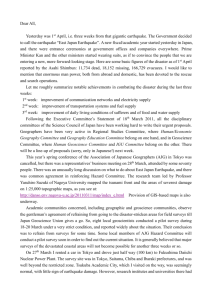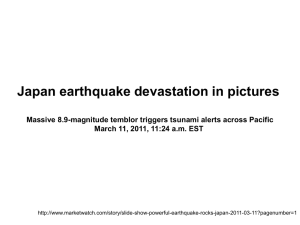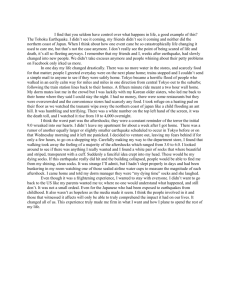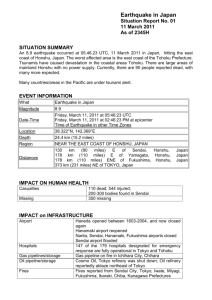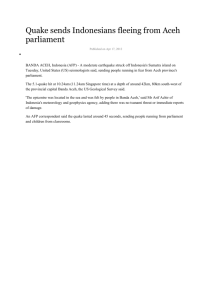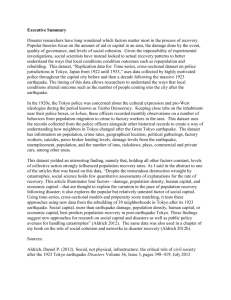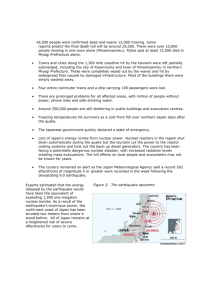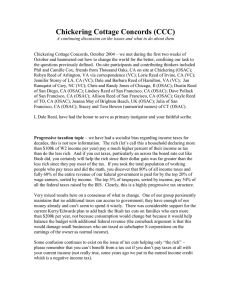OSAC report - Learning Abroad Center
advertisement
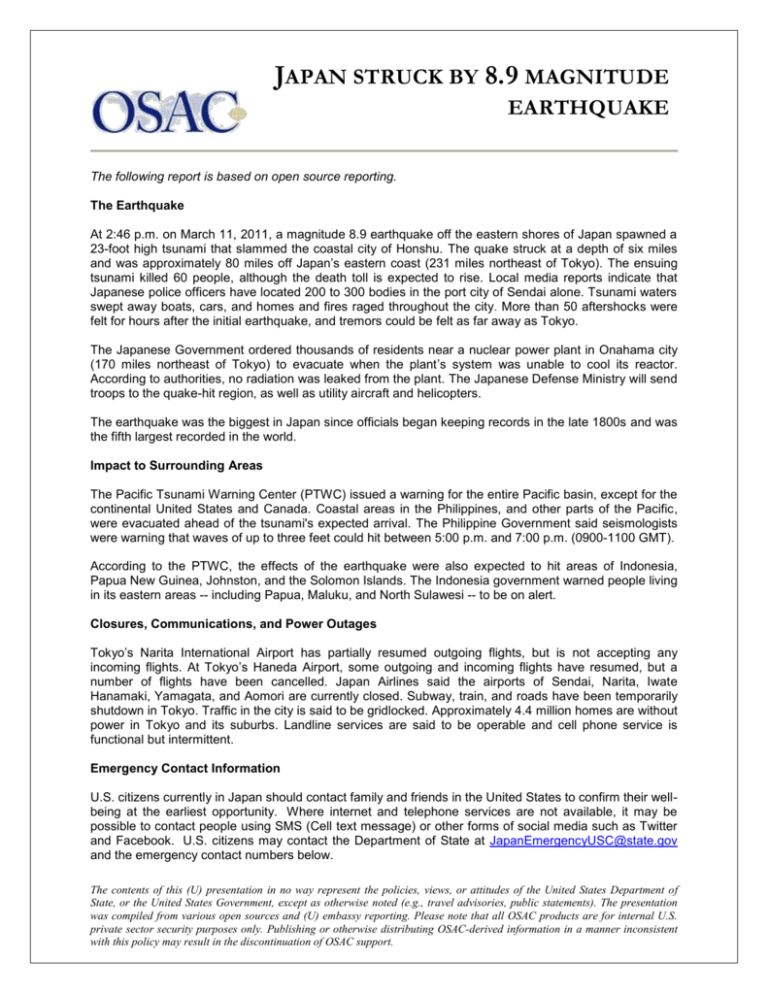
JAPAN STRUCK BY 8.9 MAGNITUDE EARTHQUAKE The following report is based on open source reporting. The Earthquake At 2:46 p.m. on March 11, 2011, a magnitude 8.9 earthquake off the eastern shores of Japan spawned a 23-foot high tsunami that slammed the coastal city of Honshu. The quake struck at a depth of six miles and was approximately 80 miles off Japan’s eastern coast (231 miles northeast of Tokyo). The ensuing tsunami killed 60 people, although the death toll is expected to rise. Local media reports indicate that Japanese police officers have located 200 to 300 bodies in the port city of Sendai alone. Tsunami waters swept away boats, cars, and homes and fires raged throughout the city. More than 50 aftershocks were felt for hours after the initial earthquake, and tremors could be felt as far away as Tokyo. The Japanese Government ordered thousands of residents near a nuclear power plant in Onahama city (170 miles northeast of Tokyo) to evacuate when the plant’s system was unable to cool its reactor. According to authorities, no radiation was leaked from the plant. The Japanese Defense Ministry will send troops to the quake-hit region, as well as utility aircraft and helicopters. The earthquake was the biggest in Japan since officials began keeping records in the late 1800s and was the fifth largest recorded in the world. Impact to Surrounding Areas The Pacific Tsunami Warning Center (PTWC) issued a warning for the entire Pacific basin, except for the continental United States and Canada. Coastal areas in the Philippines, and other parts of the Pacific, were evacuated ahead of the tsunami's expected arrival. The Philippine Government said seismologists were warning that waves of up to three feet could hit between 5:00 p.m. and 7:00 p.m. (0900-1100 GMT). According to the PTWC, the effects of the earthquake were also expected to hit areas of Indonesia, Papua New Guinea, Johnston, and the Solomon Islands. The Indonesia government warned people living in its eastern areas -- including Papua, Maluku, and North Sulawesi -- to be on alert. Closures, Communications, and Power Outages Tokyo’s Narita International Airport has partially resumed outgoing flights, but is not accepting any incoming flights. At Tokyo’s Haneda Airport, some outgoing and incoming flights have resumed, but a number of flights have been cancelled. Japan Airlines said the airports of Sendai, Narita, Iwate Hanamaki, Yamagata, and Aomori are currently closed. Subway, train, and roads have been temporarily shutdown in Tokyo. Traffic in the city is said to be gridlocked. Approximately 4.4 million homes are without power in Tokyo and its suburbs. Landline services are said to be operable and cell phone service is functional but intermittent. Emergency Contact Information U.S. citizens currently in Japan should contact family and friends in the United States to confirm their wellbeing at the earliest opportunity. Where internet and telephone services are not available, it may be possible to contact people using SMS (Cell text message) or other forms of social media such as Twitter and Facebook. U.S. citizens may contact the Department of State at JapanEmergencyUSC@state.gov and the emergency contact numbers below. The contents of this (U) presentation in no way represent the policies, views, or attitudes of the United States Department of State, or the United States Government, except as otherwise noted (e.g., travel advisories, public statements). The presentation was compiled from various open sources and (U) embassy reporting. Please note that all OSAC products are for internal U.S. private sector security purposes only. Publishing or otherwise distributing OSAC-derived information in a manner inconsistent with this policy may result in the discontinuation of OSAC support. U.S. citizens in Japan are encouraged to enroll in the Smart Traveler Enrollment Program (STEP) at the following website: https://travelregistration.state.gov. U.S. citizens without internet access may enroll directly at the U.S. Embassy or U.S. Consulates. By enrolling, U.S. citizens make it easier for the Embassy/Consulates to contact them in case of emergency. Updated information on travel and security in Japan may be obtained from the Department of State by calling 1-888-407-4747 toll-free in the United States and Canada or, for callers outside the United States and Canada, a regular toll line at 1-202-501-4444. For further information, please consult the Country Specific Information for Japan, as well as the Worldwide Caution, which can be found at www.travel.state.gov. Please visit the OSAC website to view the full Japan Travel Alert. For Further Information Please direct any questions regarding this report or the general security situation in Japan to OSAC’s Regional Coordinator for East Asia Pacific. The contents of this (U) presentation in no way represent the policies, views, or attitudes of the United States Department of State, or the United States Government, except as otherwise noted (e.g., travel advisories, public statements). The presentation was compiled from various open sources and (U) embassy reporting. Please note that all OSAC products are for internal U.S. private sector security purposes only. Publishing or otherwise distributing OSAC-derived information in a manner inconsistent with this policy may result in the discontinuation of OSAC support.
